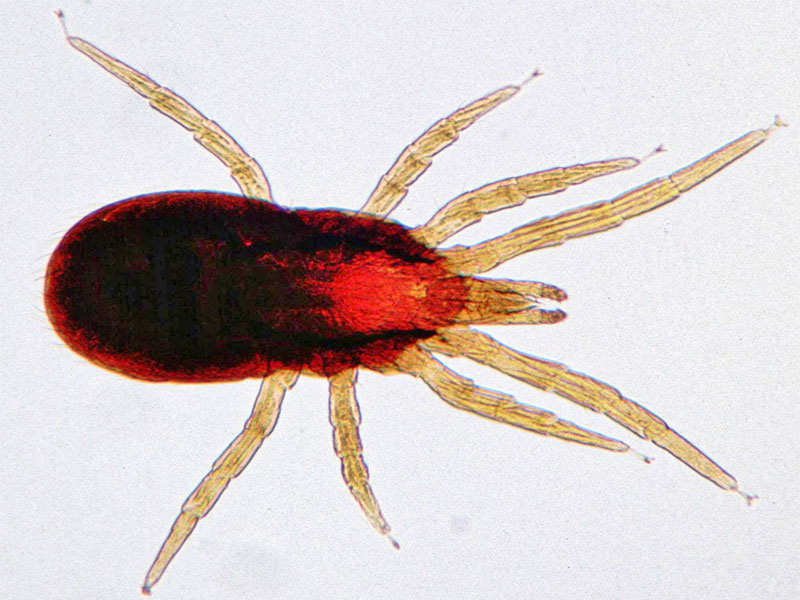Flour mite and Cheese mite infestation

Flour Mite Infestation
The Flour mite is the most common kind of mite infesting stored products. It infests products such as flours, corn, seeds, old cheese and all kinds of fodder. It is pale in colour, pearly or grey with yellow to pink,red or brown legs, each of which ends with a claw.
Typical sign of Flour Mite infestation is the presence of sticky sweet smell and a change of taste. The product infested by Flour Mites are not suitable for consumption and should be disposed of. If such products are consumed they may lead to health problems such as diarrhoea in humans and pets or farm animals. When animals consume Flour Mite-infested products, they may also experience symptoms such as inflammation of the small intestine in dogs.
An easy way to check whether a flour is infested with this pest is to spread a small amount on an even surface and leave it for 15 minutes. In case that there are Flour Mites already present in flour storage, the affected surface of the flour becomes uneven, as an indication that the flour is infested.
Cheese Mite Infestation
Cheese Mites are from the same family as the Flour Mites. They are very often found in cheeses, which has given them their name. However, these mites can also infest products such as damp flours, corn, insect collections, old honeycombs, and various stored products. This pest can cause dermatitis in contact with people.
The typical signs of Cheese Mite infestation are small holes in cheeses, gnawed by the mites, spoiled stored products with significant sweet sticky smell, grey powder on the surface of cheeses. This powder consists of the faeces of the mites and the actual Cheese Mites. The same way used for the Flour Mite can be used to identify whether a Cheese Mite infestation is present – spreading a small amount of flour and leaving it for 15 minutes. If the surface of the flour has become uneven, then the flower is considered infested.
Flour mite and Cheese mite control

The Flour Mite and the Cheese Mite infestations can be controlled by regular checks of the stored products kept in domestic or commercial premises. It is important that products are kept dry and there is minimal to no humidity present in the containers or the spaces, where the products are stored.
In case of presence of Flour Mite or Cheese Mite infestation, fumigation or surface spray is recommended for their complete extermination. The mite eggs are popular for being resistant to some insecticides, which requires for the specific product to be used in higher concentration, compared to fumigation of other pests. Heat treatment with hot air is another effective way to eradicate all life stages of the mites.
Prime Pest Control provides Flour Mite and Cheese Mite infestation treatment, control and prevention services in North, South, West and East London and the surrounding counties. Upon request, our experienced and trained by the British Pest Control Association (BPCA) pest technicians could inspect and risk assess your domestic, business or commercial premises, consider all your needs and requirements and then provide a tailored integrated pest management plan.
About Flour mite and Cheese mite
About Flour Mite
The Flour Mites (Acarus Siro) vary in their colour – it might be pearly, greyish white or even pale. The colour of their legs also varies – it might be anything from pale yellow to reddish-brown. All legs end with a claw. The Flour Mites have a smooth soft body with no wings. They can reach size of up to 0.5 mm. The younger Flour Mites look similar to the adult ones.
Usually, the female Flour Mites lay between 500 and 800 eggs, at a rate of 20-30 eggs per day. The eggs are about 0.12 mm long and are white in colour with smooth surface. The Flour Mite life cycle consists of larval, nymph and adult stages. After completing two nymph stages, these mites turn into a diapause form called hypopus. In this form the Flour Mites are resistant to desiccation and almost completely immobile. The wall of their body becomes harder and suckers are formed on the underside of each mite. This allows them disperse attaching to various insects and animals.
Depending on the conditions, the whole cycle can be completed within 9 to 11 days. The Flour Mites can survive at temperatures as low as 0 degrees Celsius to 4 Celsius, however, certain level of humidity should be available.
About Cheese Mite
The Cheese Mite (Tyriphagus Casei) comes from the same family as the Flour Mite. They resemble each other, however, the Cheese Mite is larger in size and its legs and mouthparts are tanned in colour. The female representatives of these mites are larger than the males. The number of eggs and the life cycle of the Cheese Mite is similar to the one of the Flour mite. The only difference is that the Cheese Mite can complete its cycle for 15 to 18 days depending on the conditions and if the required humidity is available. This kind of mite does not have a hypopus stage in its development cycle.
Cheese Mites are not always considered pests in cheeses. Sometimes they are purposely introduced in cheeses, so that they can become ‘ripe’ and have a typical smell and taste. The cheese can be protected using paraffin wax, which is applied in a thin layer over the cheese and will serve as protection from the mites.
